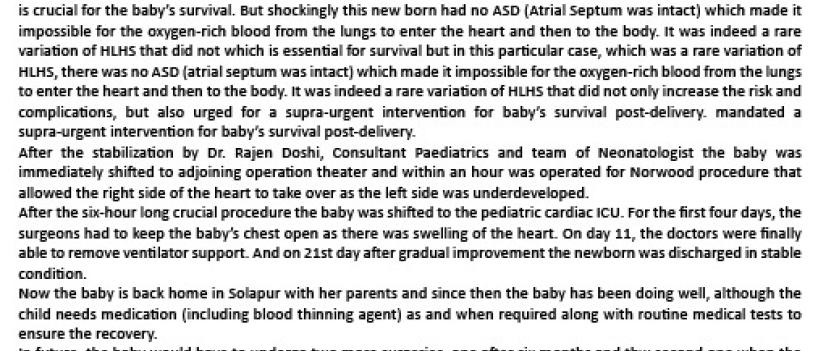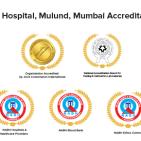One-hour-old undergone six-hour long Surgery: A life saving cardiac invasive procedure – First in Mumbai
The fetal echo conducted in the 36th week of pregnancy of Mrs. Ghorpade of Solapur was not normal. It revealed a rare heart defect in the unborn child. To reaffirm the findings, the Ghorpade family rushed to Fortis Hospital, Mulund. The fetal echocardiogram, conducted here, confirmed the diagnosis of Hypoplastic Left Heart Syndrome (HLHS) with Intact Atrial Septum. Once Mrs. Ghorpade was examined by the Gynaecologist here at Fortis, Mulund, she was found to be in her early labour and was admitted to the hospital. The very next day a planned C-section was performed by Dr. Atul Gantara, Consultant – Obstetrician and Gynecologist. As soon as the baby was born, a screening echo was done and the finding was even more surprising.
Usually in babies born with HLHS, a hole inside the heart between its two upper chambers (ASD) is present. This hole is crucial for the baby’s survival. But shockingly this new born had no ASD (Atrial Septum was intact) which made it impossible for the oxygen-rich blood from the lungs to enter the heart and then to the body. It was indeed a rare variation of HLHS that did not which is essential for survival but in this particular case, which was a rare variation of HLHS, there was no ASD (atrial septum was intact) which made it impossible for the oxygen-rich blood from the lungs to enter the heart and then to the body. It was indeed a rare variation of HLHS that did not only increase the risk and complications, but also urged for a supra-urgent intervention for baby’s survival post-delivery. mandated a supra-urgent intervention for baby’s survival post-delivery.
After the stabilization by Dr. Rajen Doshi, Consultant Paediatrics and team of Neonatologist the baby was immediately shifted to adjoining operation theater and within an hour was operated for Norwood procedure that allowed the right side of the heart to take over as the left side was underdeveloped.
After the six-hour long crucial procedure the baby was shifted to the pediatric cardiac ICU. For the first four days, the surgeons had to keep the baby’s chest open as there was swelling of the heart. On day 11, the doctors were finally able to remove ventilator support. And on 21st day after gradual improvement the newborn was discharged in stable condition.
Now the baby is back home in Solapur with her parents and since then the baby has been doing well, although the child needs medication (including blood thinning agent) as and when required along with routine medical tests to ensure the recovery.
In future, the baby would have to undergo two more surgeries, one after six months and thw second one when the baby is 3-4 years of age, but the risk associated with these two surgeries are considerably low.
HLHS is a rare congenital heart defect, one in ten thousand, where the left side of the heart is poorly formed affecting the normal blood flow in the heart. If not treated, in later years the child does face the increased risk of: Heart Failure, Pulmonary Hypertension, leading to demise within 2 years of age.



















